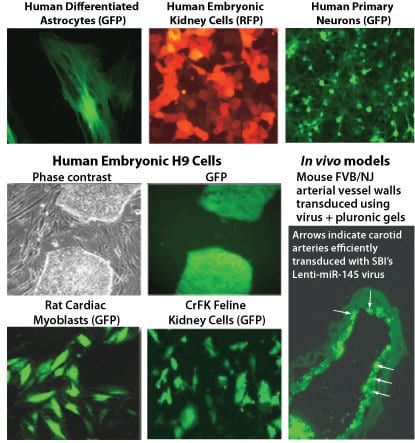pSIF1-H1-siLuc-copGFP Positive Transduction Control
- Easily visualize and quantify transduction efficiency with copGFP
- Optimize transduction conditions for your cell line
- Test the sensitivity of target cells to FIV-based lentiviral transduction
- Maximum emission wavelength: 502 nm
- Maximum excitation wavelength: 482 nm
Products
| Catalog Number | Description | Size | Price | Quantity | Add to Cart | |||
|---|---|---|---|---|---|---|---|---|
| LV201B-1 | pSIF1-H1-siLuc-copGFP Positive Transduction Control (pre-packaged virus) | >1 x 10^6 IFUs | $657 |
|
||||
| LV201PB-1 | pSIF1-H1-siLuc-copGFP Positive Transduction Control (plasmid) | 10 µg | $584 |
|
||||
Overview
Overview
Gain the confidence to move forward with informative controls
While lentiviral transduction can be a powerful and effective method for delivering expression cassettes to target cells, enabling stable expression of genes, miRNAs, shRNAs, etc., some cell lines are transduced less efficiently than others. To help with lentiviral transduction optimization and troubleshooting, SBI offers a series of positive transduction controls that come as pre-packaged, ready-to-transduce lentiviral particles as well as ready-to-transfect and package lentivector plasmids. The pSIF1-H1-siLuc-copGFP Positive Transduction Control enables quantitation of FIV-based lentiviral transduction efficiency using the bright copGFP protein.
- Easily visualize and quantify transduction efficiency with copGFP
- Optimize transduction conditions for your cell line
- Test the sensitivity of target cells to FIV-based lentiviral transduction
pSIF1-H1-siLuc-copGFP expresses the full-length copGFP gene with human-optimized codons from the CMV promoter for high levels of expression in mammalian cells. The copGFP marker is a novel natural green monomeric GFP-like protein from copepods (Pontellina sp.). The copGFP protein is a non-toxic, non-aggregating protein with fast protein maturation and high stability at a wide range of pH (pH 4 – 12). copGFP does not require any additional cofactors or substrates and has very bright fluorescence that exceeds at least 1.3 times the brightness of EGFP, the widely used Aequorea victoria GFP mutant. The copGFP protein emits green fluorescence with the following characteristics:
- Maximum emission wavelength: 502 nm
- Maximum excitation wavelength: 482 nm
- Quantum yield: 0.6
- Extinction coefficient: 70,000 M-1 cm-1
References
How It Works
Supporting Data
FAQs
Resources
Citations
Related Products
Products
| Catalog Number | Description | Size | Price | Quantity | Add to Cart | |||
|---|---|---|---|---|---|---|---|---|
| LV201B-1 | pSIF1-H1-siLuc-copGFP Positive Transduction Control (pre-packaged virus) | >1 x 10^6 IFUs | $657 |
|
||||
| LV201PB-1 | pSIF1-H1-siLuc-copGFP Positive Transduction Control (plasmid) | 10 µg | $584 |
|
||||
Overview
Overview
Gain the confidence to move forward with informative controls
While lentiviral transduction can be a powerful and effective method for delivering expression cassettes to target cells, enabling stable expression of genes, miRNAs, shRNAs, etc., some cell lines are transduced less efficiently than others. To help with lentiviral transduction optimization and troubleshooting, SBI offers a series of positive transduction controls that come as pre-packaged, ready-to-transduce lentiviral particles as well as ready-to-transfect and package lentivector plasmids. The pSIF1-H1-siLuc-copGFP Positive Transduction Control enables quantitation of FIV-based lentiviral transduction efficiency using the bright copGFP protein.
- Easily visualize and quantify transduction efficiency with copGFP
- Optimize transduction conditions for your cell line
- Test the sensitivity of target cells to FIV-based lentiviral transduction
pSIF1-H1-siLuc-copGFP expresses the full-length copGFP gene with human-optimized codons from the CMV promoter for high levels of expression in mammalian cells. The copGFP marker is a novel natural green monomeric GFP-like protein from copepods (Pontellina sp.). The copGFP protein is a non-toxic, non-aggregating protein with fast protein maturation and high stability at a wide range of pH (pH 4 – 12). copGFP does not require any additional cofactors or substrates and has very bright fluorescence that exceeds at least 1.3 times the brightness of EGFP, the widely used Aequorea victoria GFP mutant. The copGFP protein emits green fluorescence with the following characteristics:
- Maximum emission wavelength: 502 nm
- Maximum excitation wavelength: 482 nm
- Quantum yield: 0.6
- Extinction coefficient: 70,000 M-1 cm-1



